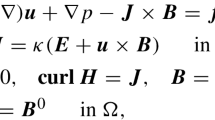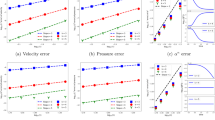Abstract
The application of the conjugate residual method to the indefinite system resulting from the finite element approximation of the incompressible Navier-Stokes equations is studied. The possibility to use an element-by-element preconditioner for the acceleration of the convergence is also discussed. With this scheme, one can achieve significant savings in storage without ever forming the large total matrix. Furthermore, the hybrid finite element mesh, a mixture of the structured and unstructured mesh subdivisions, is employed to minimize the storage requirement. The numerical simulations of the Karman vortex street, a driven cavity flow and the flow in a safety valve are presented to demonstrate the applicability of the proposed strategies.
Similar content being viewed by others
References
Brezzi, F. (1974): On the existence, uniqueness and approximation of saddlepoint problems arising from Lagrangian multipliers. RAITRO 8, 129–151
Donea, J.; Giuliani, S.; Laval, H.; Quartapelle, L. (1982): Finite element solution of the unsteady Navier-Stokes equations. Comp. Meth. Appl. Mech. Engng. 30, 53–73
Eguchi, Y.; Fuchs, L. (1986): Conjugate-gradient methods applied to the finite-element approximation of the Navier-Stokes equations. In: Yagawa, G.; Atluri, S. N. (eds): Proc. Int. Conf. Comp. Mech., VII-107. Berlin, Heidelberg, New York: Springer
Ghia, U.; Ghia, K. N.; Shin, C. T. (1982): High-Re solution for incompressible flow using the Navier-Stokes equations and a multi-grid method. J. comp. Phys. 48, 387–411
Gresho, P. M.; Lee, R. L.; Sam, R. (1978): Advection-dominated flows with emphasis on the consequences of mass lumping. In: Gallager, R. H.; Zienkiewicz, O. C.; Oden, J. T.; Morandi Cecchi, M.; Taylor, C. (eds.): Finite elements in fluids, Vol. 3, pp. 335–351. Chichester: Wiley
Gresho, P. M.; Lee, L. R.; Sani, R. L. (1980): On the time-dependent solution of the incompressible Navier-Stokes equations in two and three dimensions. In: Taylor, C.; Morgan, K. (eds.): Recent advances in numerical methods in fluids, Vol. 1, pp. 27–79. Swansea: Pineridge Press
Gresho, P. M.; Chan, S. T. (1985): A new semi-implicit method for solving the time-dependent convervation equations for incompressible flow. In: Taylor, C.; Olson, M. D.; Gresho, P. M.; Habashi, W. G. (eds.): Proc. 4th Int. Conf. Numer. Meth. Laminar and Turbulent Flow, pp. 3–21. Swansea: Pinerdige Press
Hughes, T. J. R.; Levit, I.; Winget, I. (1983): An element-by-element algorithm for problems of structural and solid mechanics. Compt. Meth. Appl. Mech. Engng. 36, 241–254
Hughes, T. J. R.; Ferencz, R. M.; Hallquist, J. O. (1986): Experience with an element-by-element iterative strategy, presented at the workshop on: Scientific application and algorithm design for high speed computing, Illinois
Ito, K. (1984): An iterative method for indefinite systems of linear equations. NASA ICASE rept. No. 84-13
Jackson, C. P.; Robinson, P. C. (1985): A numerical study of various algorithm related to the preconditioned conjugate gradient method. Int. J. Numer. Meth. Engng. 21, 1315–1338
Mizukami, A.; Tsuchiya, M. (1984): A finite element method for the three-dimensional non-steady Navier-Stokes equations. Int. J. Numer. Meth. in Fluids 4, 349–357
Mochizuki, O.; Yamabe, H.; Yamada, H. (1986): Flow in a two-dimensional square cavity. Translation of Japan society of mechanical engineering, 52, 1589–1592 (in Japanese)
Nour-Omid, B.; Parlett, B.N. (1985): Element preconditioning using splitting techniques. SIAM J. Sci. Stat. Compt. 6, 761–769
Robichaud, M.; Tanguy, P. (1985): Incomplete factorization in 3-D incompressible fluid flow problems. In: Taylor, C.; Olson, M. D.; Gresho, P. M.; Habashi, W. G. (eds.) Proc. 4th Int. Conf. Numer. Meth. Laminar and Turbulent Flow, pp. 1783–1793. Swansea: Pineridge Press
Saad, Y. (1982): The Lanczos biorthogonalization algorithm and other oblique projection methods for solving large unsymmetric system. SIAM J. Numer. Anal. 19, 485–506
Sallet, D. W. (1984): Thermal hydraulics of valves for nuclear applications. Nucl. Sci. Engng. 88, 220–244
Winget, J.; Hughes, T. J. R. (1985): Solution algorithms for nonlinear transient heat conduction analysis employing elementby-element iterative strategies. Compt. Meth. Appl. Mech. Engng. 52, 711–815
Author information
Authors and Affiliations
Additional information
Communicated by S.N. Atluri, October 13, 1986
Rights and permissions
About this article
Cite this article
Eguchi, Y., Yagawa, G. & Fuchs, L. A conjugate-residual-FEM for incompressible viscous flow analysis. Computational Mechanics 3, 59–72 (1988). https://doi.org/10.1007/BF00280752
Issue Date:
DOI: https://doi.org/10.1007/BF00280752




